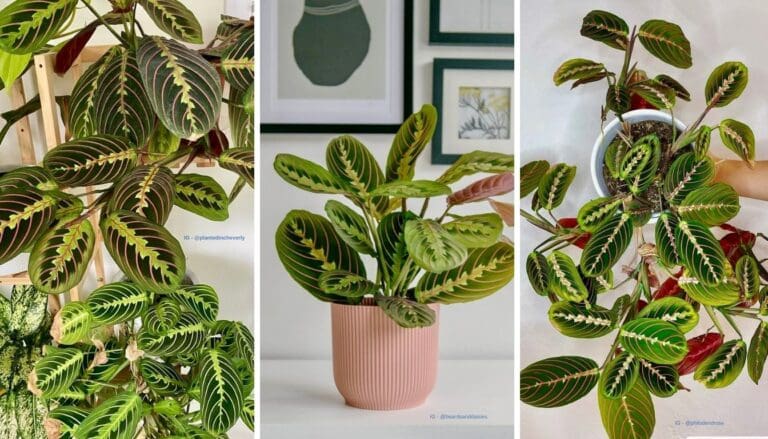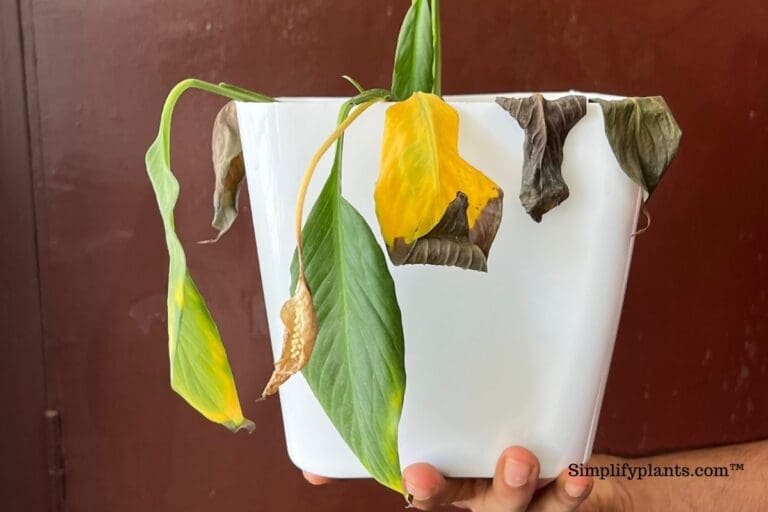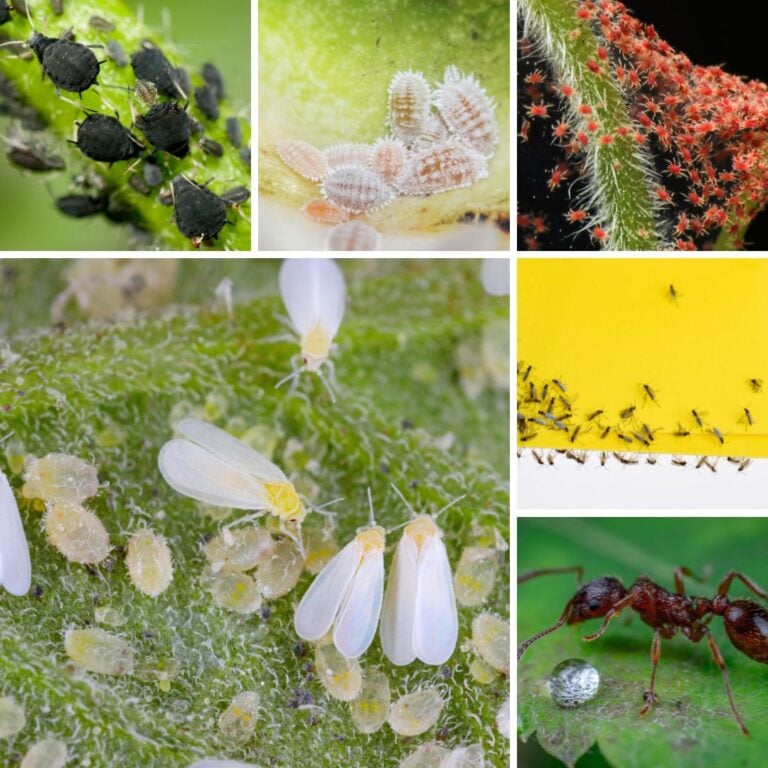7 Signs Your Plant Needs Less Water This Fall
Sometimes I catch myself thinking that more water must mean healthier plants. But too much water can actually do more harm than good, especially as the seasons shift.
I’ve found that watching how my plants react is the best way to know when it’s time to ease up.
Giving plants the right amount of water keeps them strong and happy. If I spot the early signs, I can save my plants a lot of stress.
Please note: Simplify Plants is reader-supported. As an Amazon Associate, I earn from qualifying purchases made by our readers with no extra cost added to you all! Some links in the post are affiliate links and I get a commission from purchases made through links in the post.
1) Yellowing leaves starting at the tips
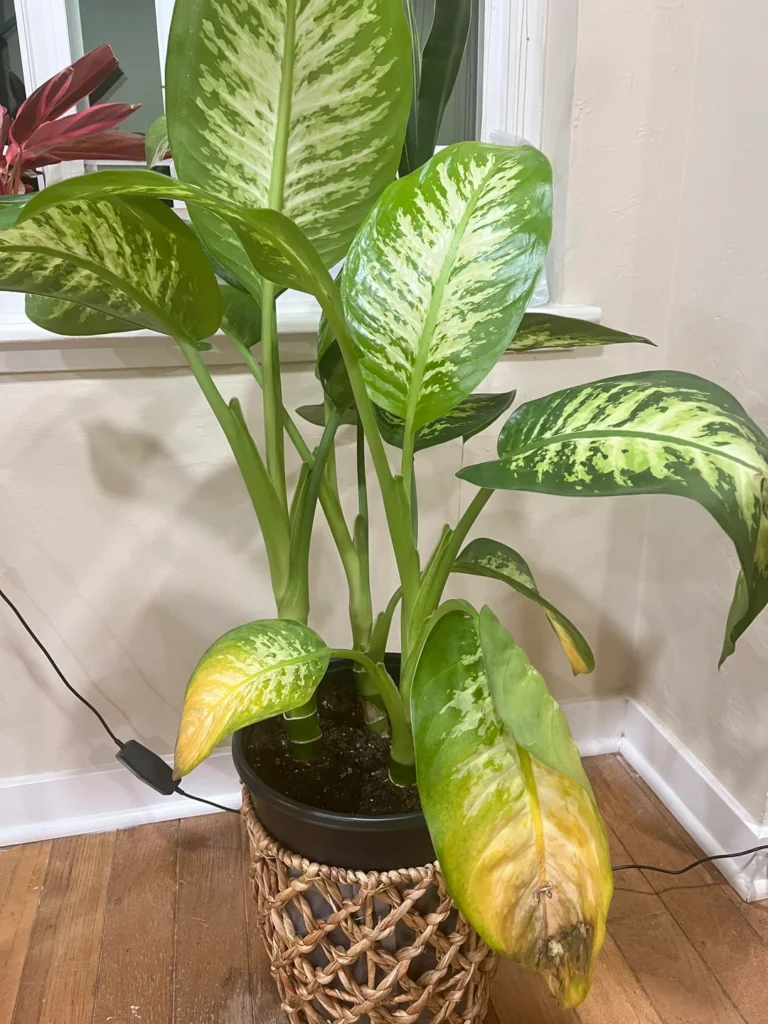
I always keep an eye on the tips of my plant’s leaves for early warnings. When I see yellow creeping in at the tips, it’s usually a sign I’ve been a little too generous with the watering can.
This can happen to a lot of different houseplants. Too much water basically drowns the roots. They can’t breathe, and then they can’t move nutrients around.
The first thing I see is yellowing at the leaf tips, and it slowly spreads down the leaf. If those yellow tips feel soft and limp, it’s even more likely from overwatering.
The tips might look soggy or thin—not dry and crispy like they would if I’d forgotten to water. Soft, yellow tips? Classic too-much-water warning.
It’s easy to assume yellow tips mean my plant is thirsty, but every time I see it, I try to pause and check the soil. If it’s wet for days, that’s my cue to back off.
Yellowing can be from other things, but if it starts at the tips and the soil’s still wet, overwatering is a real suspect. I try to water less and let the top of the soil dry out before I reach for the watering can again.
I always look out for those yellow tips—it’s basically the plant’s way of asking for a little break from watering.
2) Wilting leaves despite moist soil

I always check the soil before I water, but sometimes the leaves are wilting even though the soil is still damp.
That’s a pretty clear sign my plant might be getting too much water, not too little. When I see droopy leaves and the soil isn’t dry, I try to resist the urge to water more.
Overwatering can actually make a plant look thirsty. Roots need both water and air. If I water too often, the roots can suffocate and start to rot.
If the soil is still moist and my plant looks sad, I wait before watering again. Sometimes I poke my finger or a stick a little deeper to check if it’s wet below the surface.
If it’s still wet a couple inches down, I definitely hold off. Some plants, like succulents, really don’t need much water.
If my succulent’s leaves are wilting but the soil is wet, I know it’s time to give it a longer break. Yellow, soft, or mushy leaves along with wilting? That’s another clue there’s too much water.
I also make sure my pots have drainage holes. Good drainage is a lifesaver for root health.
When I see wilting and the soil’s still wet, it’s my plant’s way of saying, “Please, no more water for now.”
3) Soil feels consistently soggy

One of the biggest red flags for me is how wet the soil feels. If I press my finger in and it’s always wet, that’s not good.
Healthy plants don’t want their roots sitting in soggy soil. Too much water keeps roots from getting the air they need.
This can cause weak growth or even root rot. When my soil feels more like a wet sponge than a damp towel, I know I need to water less.
The soil should be a bit moist, not soaked. Sometimes soggy soil is because the pot doesn’t drain well.
I always check that water can run out the bottom so it doesn’t collect around the roots. Even if the top looks dry, the bottom might still be holding a lot of water.
I’ll stick a wooden skewer or my finger deep into the pot to check. If I notice a musty smell, that’s another clue.
Wet soil that never dries out can start to grow mold and smell kind of funky. Letting the soil dry out almost all the way before watering again really helps.
Most houseplants like their soil to dry out on top between waterings. As the seasons change, plants use water more slowly.
If I keep watering the same as always, the soil just stays soggy. I try to adjust my routine when the weather cools down or gets less sunny.
4) Root rot smell nearby
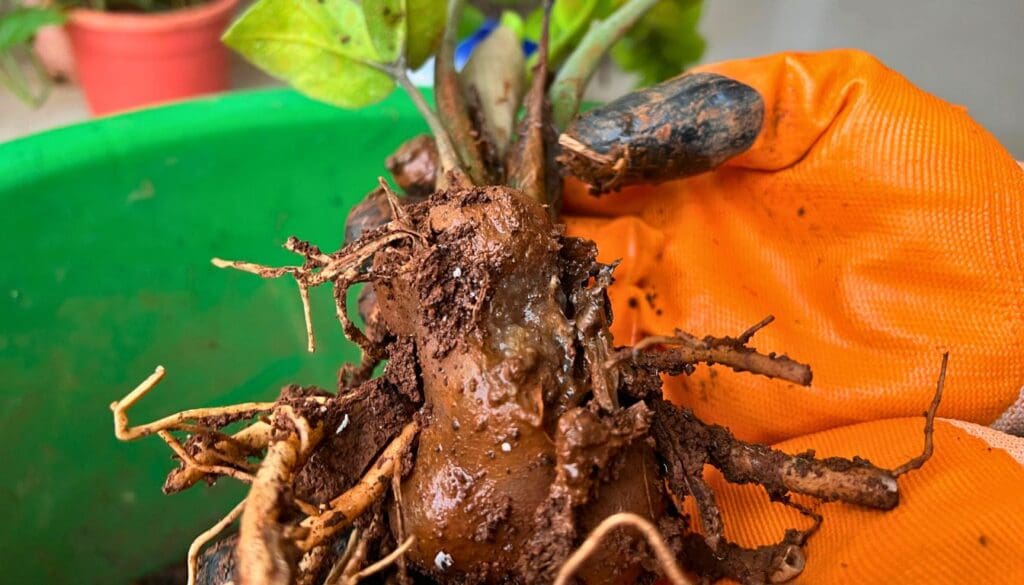
Sometimes when I walk by my plant, I get a bad smell—kind of like rotten eggs or damp soil.
That’s a big hint that something’s wrong. Healthy roots don’t smell. If there’s a foul odor, it usually means the roots are too wet and starting to rot.
I’ll check around the base of the plant. If the smell is strong, I know I’ve probably been overwatering.
Root rot happens when the soil stays wet for too long. Bacteria and fungi love that environment, and they attack the roots, which makes that gross smell.
If I notice it, I let the soil dry out before watering again. If the smell sticks around, I’ll gently pull the plant out and check the roots.
Rotten roots are brown or black and mushy. Healthy ones should be white or tan and feel firm.
If I find some bad roots, I snip them off with clean scissors and replant in fresh, dry soil. I always double-check for drainage holes so water can escape.
Waiting until the top inch of soil is dry before watering again helps a lot. Keeping an eye—and honestly, a nose—on my plants helps me catch problems early.
5) Mold or algae growth on soil surface
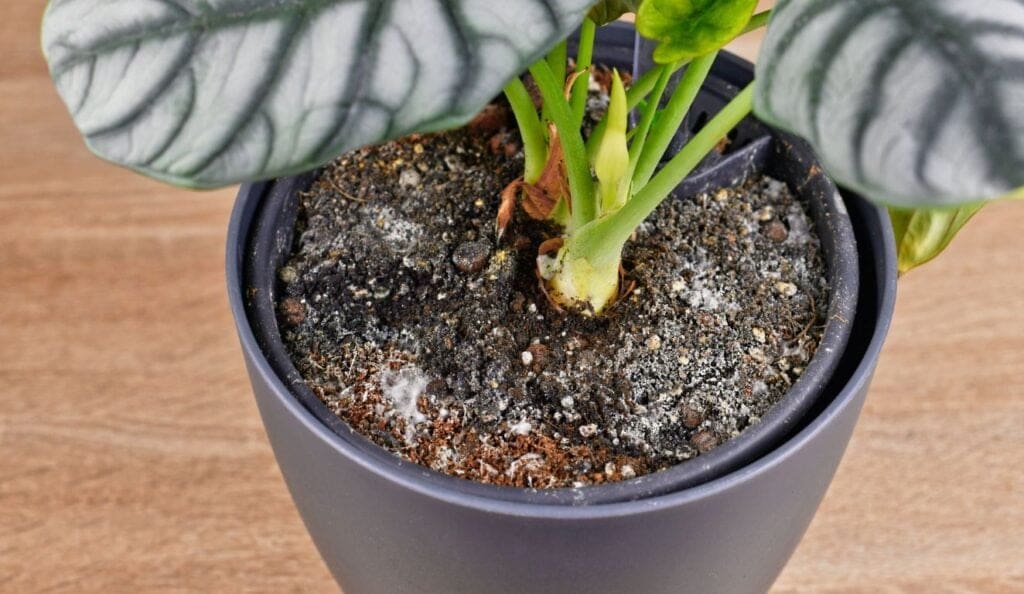
Every so often, I spot a fuzzy white layer or green patches on top of my plant’s soil. That’s usually a sign there’s too much moisture hanging around.
Mold and algae love damp spots. If I see them growing, it means my plant’s spot is too wet or humid.
Overwatering makes it easy for these things to pop up. I know roots need air to stay healthy, and soggy soil just doesn’t let that happen.
If the surface is always wet, that’s perfect for mold or algae. When I spot any, I check my watering routine right away.
Letting the top layer of soil dry before watering again usually helps. I also make sure the pot drains well.
Sometimes I’ll scrape off the top layer of soil and move the plant to a sunnier or breezier spot. Better sunlight or airflow dries the soil faster and helps stop mold or algae from coming back.
Healthy soil shouldn’t stay wet for days on end. If I keep seeing mold or algae, I water less often or try a lighter soil mix.
Catching these signs early and tweaking my care routine keeps my plants looking their best.
6) Drooping new growth

I always notice new leaves and stems when I check my plants. If the freshest growth is drooping, it’s usually a sign something’s off with watering.
New shoots should look firm and strong. If they’re limp or floppy, there might be too much water in the soil.
Excess water makes it hard for roots to get enough oxygen. That lack of oxygen makes the youngest parts droop.
I know drooping can also be from under-watering, so I always check the soil. If it’s wet but the new leaves are still limp, that’s a warning sign of overwatering.
The combo of damp soil and floppy new growth is a good clue my plant wants less water. Sometimes the plant looks fine overall, but just the new tips are sagging.
That’s when I double-check my watering habits. I always make sure the pot has good drainage to avoid this.
Catching drooping new growth early helps me stop bigger root problems before they start.
7) Leaves falling off prematurely

I’ve noticed that when my plants start dropping leaves too soon, it often means I’ve been watering too much.
Healthy plants usually keep their leaves through the season unless something’s stressing them out. Too much water can drown the roots.
When roots are too wet, they can’t pull in enough oxygen, and that stress makes leaves fall before their time.
I look for leaves falling suddenly, especially if they’re still green or look healthy. If leaves drop in clusters or all at once, that’s a big clue.
When this happens, I always pause my watering routine. Letting the soil dry out usually helps the plant bounce back.
Sometimes old leaves fall naturally, but rapid or early leaf drop is a red flag. If it keeps happening, I know I need to rethink how much I’m watering.
Watching for leaf drop helps me catch watering problems early. If I catch it in time, my plant usually recovers just fine.
Understanding Overwatering and Its Risks
Watering too much can actually hurt my plants. Too much water leads to weak roots and makes it easier for pests and diseases to move in.
How Overwatering Impacts Plant Health
When I end up giving my plants more water than they really need, their roots stay wet for too long. That’s when root rot can set in—roots turn mushy and brown, not the nice firm white you want.
Healthy roots actually need both water and air. If the soil is always soggy, there’s just no way for air to get in.
Plants that are overwatered might look wilted and droopy, even if the soil is wet. Sometimes the leaves start turning yellow or just fall off for no good reason.
Overwatering also washes away helpful nutrients from the soil, so my plants can’t get what they need to grow strong.
Keeping soil too wet makes it way too easy for fungus and mold to show up. That leads to spots on leaves, fuzzy surfaces, or honestly, a pretty gross smell.
Even bugs like gnats seem to love plants that stay wet for days.
Common Causes of Overwatering in Different Seasons
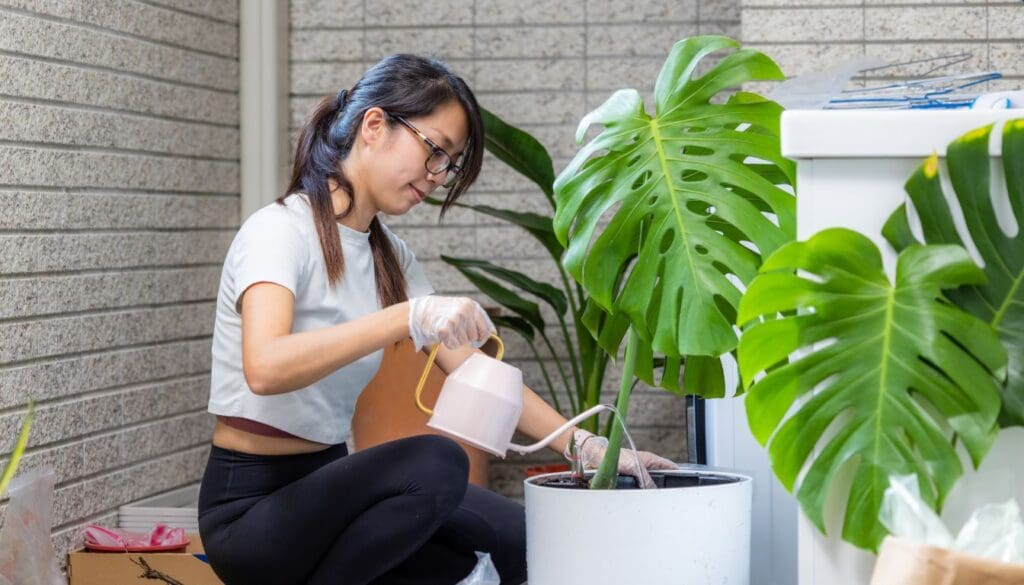
I’ve noticed that different seasons really change how much water my plants actually need. In the spring and summer, warm weather and bright sun help the soil dry out faster, so plants might use up water quicker.
But in the fall and winter, sunlight drops and temperatures cool down a lot. This means my plants don’t need as much water, and wet soil can just stay soggy forever.
It’s easy to overwater if I stick to the same schedule all year, even when my plants are basically just sitting there.
Sometimes I forget that big pots or pots with no drainage holes hang onto water for much longer. Using heavy soil that doesn’t drain well can make things worse, too.
I always try to check my pots and soil before adding more water, especially in those cooler or darker months.
Adjusting Your Watering Routine for Changing Seasons
I really have to keep an eye on my plant’s water needs as the weather shifts. It’s surprisingly easy to overdo it if I’m not paying attention or if the season changes faster than I expected.
Recognizing Seasonal Changes in Plant Needs
When days get shorter and temperatures drop, my plant slows down. Growth often stops or just slows way down in fall and winter.
This means my plant is taking up less water from the soil. I look for a few key signs—less new growth, tougher or darker leaves, and soil that just isn’t drying out.
In these months, watering on the same summer schedule can lead to soggy roots. Another thing I notice: my plant might need less water if it’s not sitting in direct sunlight as much.
Bright, hot days dry soil out quicker than cool, cloudy days. I always watch for those changes and try to adjust how often I water.
Tips for Monitoring Soil Moisture Accurately
Checking the soil is honestly the best way to know when to water. I usually feel the top two inches of soil with my finger before adding water. If it’s still damp, I wait.
A simple wooden stick or chopstick works, too. I just push it into the soil and see if it comes out wet or dry.
Sticking to a set schedule doesn’t really work when light and temperature change. For even better accuracy, I sometimes use a soil moisture meter.
It gives clear readings and helps me avoid watering mistakes. I check often, especially when I notice temperature swings or less sun in my space.
Frequently Asked Questions
Here are some of the most common questions I get about watering plants. They cover the difference between too much and too little water, what signs to look for, and steps to help your plants bounce back.
How can I distinguish between overwatering and underwatering symptoms in my plant?
Overwatering usually causes yellow leaves that feel soft or mushy. The soil might stay wet and, honestly, you may notice a pretty bad smell.
Underwatering makes leaves dry or crispy. The soil feels dry and pulls away from the edges of the pot.
What are the telltale signs that indicate an outdoor plant has been overwatered?
I look for yellowing leaves, wilting even when the soil is wet, and a moldy or rotten smell near the roots. Sometimes, I’ll see algae or mold on the soil surface too.
Can you provide tips on how to differentiate between a plant’s need for water versus more sunlight?
If leaves are pale and reaching toward the window, my plant probably wants more sunlight. If the tips are brown and the soil is dry, it usually just needs water.
Always check the soil before adding water.
What should I do if I’ve accidentally given too much water to my plant?
First thing, I stop watering right away. Then, I gently remove the plant from its pot and let the roots dry out a bit.
I clean off any rotten roots, repot in fresh, dry soil, and keep it somewhere with good air movement.
Could you explain what underwatering plants means in simple terms?
Underwatering means I’m just not giving my plant enough water. The soil dries out and the leaves often turn brown or curl up.
What steps should I take to revive an underwatered plant effectively?
First, I like to water the plant slowly so the soil actually has a chance to soak it all up. No point in rushing, right?
If I spot any leaves that are dead or just plain crispy, I’ll snip those off. It helps the plant focus on getting healthy again.
After that, I move my plant somewhere with steady light. I keep an eye on the soil, making sure it stays evenly moist—definitely don’t want it soggy.
Note: Some images in the articles are sourced from Reddit and Other Platforms For Reference Purpose.




